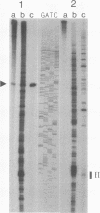Abstract
Endonucleolytic activity was detected in high-salt extracts of Chlamydia trachomatis cell lysates. This nucleolytic activity showed specificity for one strand of a PCR fragment containing the strong chlamydial promoter that regulates synthesis of two short plasmid-specified RNAs. Strand specificity was also observed with supercoiled DNA containing the same region; once again, the same strand was cleaved. The sensitive strand is the nontemplate strand for two short transcripts which initiate at the same nucleotide. Alignment of sequences on either side of the nick sites revealed a consensus which may be required for recognition of the enzymatic activity.
Full text
PDF




Images in this article
Selected References
These references are in PubMed. This may not be the complete list of references from this article.
- Amann E., Brosius J., Ptashne M. Vectors bearing a hybrid trp-lac promoter useful for regulated expression of cloned genes in Escherichia coli. Gene. 1983 Nov;25(2-3):167–178. doi: 10.1016/0378-1119(83)90222-6. [DOI] [PubMed] [Google Scholar]
- Barry C. E., 3rd, Brickman T. J., Hackstadt T. Hc1-mediated effects on DNA structure: a potential regulator of chlamydial development. Mol Microbiol. 1993 Jul;9(2):273–283. doi: 10.1111/j.1365-2958.1993.tb01689.x. [DOI] [PubMed] [Google Scholar]
- Brickman T. J., Barry C. E., 3rd, Hackstadt T. Molecular cloning and expression of hctB encoding a strain-variant chlamydial histone-like protein with DNA-binding activity. J Bacteriol. 1993 Jul;175(14):4274–4281. doi: 10.1128/jb.175.14.4274-4281.1993. [DOI] [PMC free article] [PubMed] [Google Scholar]
- Costerton J. W., Poffenroth L., Wilt J. C., Kordová N. Ultrastructural studies of the nucleoids of the pleomorphic forms of Chlamydia psittaci 6BC: a comparison with bacteria. Can J Microbiol. 1976 Jan;22(1):16–28. doi: 10.1139/m76-003. [DOI] [PubMed] [Google Scholar]
- Crenshaw R. W., Fahr M. J., Wichlan D. G., Hatch T. P. Developmental cycle-specific host-free RNA synthesis in Chlamydia spp. Infect Immun. 1990 Oct;58(10):3194–3201. doi: 10.1128/iai.58.10.3194-3201.1990. [DOI] [PMC free article] [PubMed] [Google Scholar]
- Fahr M. J., Sriprakash K. S., Hatch T. P. Convergent and overlapping transcripts of the Chlamydia trachomatis 7.5-kb plasmid. Plasmid. 1992 Nov;28(3):247–257. doi: 10.1016/0147-619x(92)90056-g. [DOI] [PubMed] [Google Scholar]
- Gralla J. D. Rapid "footprinting" on supercoiled DNA. Proc Natl Acad Sci U S A. 1985 May;82(10):3078–3081. doi: 10.1073/pnas.82.10.3078. [DOI] [PMC free article] [PubMed] [Google Scholar]
- Hatch T. P., Vance D. W., Jr, Al-Hossainy E. Attachment of Chlamydia psittaci to formaldehyde-fixed and unfixed L cells. J Gen Microbiol. 1981 Aug;125(2):273–283. doi: 10.1099/00221287-125-2-273. [DOI] [PubMed] [Google Scholar]
- Herendeen D. R., Kassavetis G. A., Barry J., Alberts B. M., Geiduschek E. P. Enhancement of bacteriophage T4 late transcription by components of the T4 DNA replication apparatus. Science. 1989 Sep 1;245(4921):952–958. doi: 10.1126/science.2672335. [DOI] [PubMed] [Google Scholar]
- Mathews S. A., Douglas A., Sriprakash K. S., Hatch T. P. In vitro transcription in Chlamydia psittaci and Chlamydia trachomatis. Mol Microbiol. 1993 Mar;7(6):937–946. doi: 10.1111/j.1365-2958.1993.tb01185.x. [DOI] [PubMed] [Google Scholar]
- Mathews S. A., Sriprakash K. S. The RNA polymerase of Chlamydia trachomatis has a flexible sequence requirement at the -10 and -35 boxes of its promoters. J Bacteriol. 1994 Jun;176(12):3785–3789. doi: 10.1128/jb.176.12.3785-3789.1994. [DOI] [PMC free article] [PubMed] [Google Scholar]
- Palmer L., Falkow S. A common plasmid of Chlamydia trachomatis. Plasmid. 1986 Jul;16(1):52–62. doi: 10.1016/0147-619x(86)90079-x. [DOI] [PubMed] [Google Scholar]
- Pearce B. J., Fahr M. J., Hatch T. P., Sriprakash K. S. A chlamydial plasmid is differentially transcribed during the life cycle of Chlamydia trachomatis. Plasmid. 1991 Sep;26(2):116–122. doi: 10.1016/0147-619x(91)90051-w. [DOI] [PubMed] [Google Scholar]
- Saiki R. K., Gelfand D. H., Stoffel S., Scharf S. J., Higuchi R., Horn G. T., Mullis K. B., Erlich H. A. Primer-directed enzymatic amplification of DNA with a thermostable DNA polymerase. Science. 1988 Jan 29;239(4839):487–491. doi: 10.1126/science.2448875. [DOI] [PubMed] [Google Scholar]
- Solbrig M. V., Wong M. L., Stephens R. S. Developmental-stage-specific plasmid supercoiling in Chlamydia trachomatis. Mol Microbiol. 1990 Sep;4(9):1535–1541. doi: 10.1111/j.1365-2958.1990.tb02064.x. [DOI] [PubMed] [Google Scholar]




